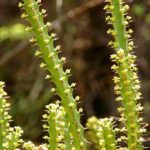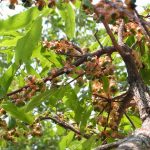TREE LIFE
October 1983
MASHONALAND CALENDAR
Tuesday October 4th : Botanic Garden Walk. Meet in the Car Park at 1645 for 1700 hours.
Thursday October 13th : The Tree Society is invited to Prof. Swift’s inaugural lecture entitled “The Death of Trees”. This is a public lecture and Prof. Swift assures us it will be easy to follow. Directions : The New Education lecture theatre, University of Zimbabwe. Enter varsity via Churchill Avenue, take first tarred road left. The road passes two turns to the right and then swings left and then sharp right and progresses northwards uphill. Take the next turn to the right and then first left. The road swings east and the New Education building is on the left.
Sunday October 16th : Saffron Walden Farm. We intend to have a look at the very interesting kopjes on this farm. A visit a few years ago went of at half cock due to a broken down bus. Our recce yielded up Nuxia congesta, Rothmannia fischeri and many others. A bus from Harare has been arranged which will leave Monomatapa Car Park at 0900 hours. The fare will be $4.50.
BOTANIC GARDEN WALK, 6TH SEPTEMBER 1983
Having discussed Allophylus of the SAPINDACEAE recently, we were pleased to be shown the confusing genus Rhus and its family the ANACARDIACEAE by Tom Muller. All ANACARDIACEAE are woody plants containing resin passages, although the leaves are not gland dotted as in the RUTACEAE. It is this feature that gives the crushed Rhus leaf that characteristic smell not found in Allophylus. Anacardium itself is the cashew nut whose cultivation we learn from Janet Webber is being extensively encouraged by German agricultural aid programmes in the Third World. The useful mango and pistachio nut also belong to this family. The indigenous ANACARDIACEAE fall into three groups: firstly those with compound leaves, secondly the simple leaves represented by Ozoroa and thirdly the trifoliate genus Rhus.
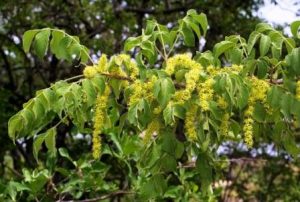
Lannea schweinfurthii, ex L.stuhlmannii. Photo: Bart Wursten. Flora of Zimbabwe
The first group, represented by Lannea and the marula, Sclerocarya, have imparipinnately compound leaves which fall in the dry season exposing the stubby, blunt tipped twigs we have been calling ‘ET fingers’. Tom first showed us Lannea schweinfurthii, ex L. stuhlmannii, and pointed out the sessile leaflets and the smooth trunk which peels in large square flakes, in contrast to Sclerocarya where the leaflets have long petiolules and the bark flakes are rounder. L. schweinfurthii which has a deep red slash, is a middle to lowveld tree usually found on deep sand in the jesse, in dry forest and riverine habitats.
All round Mashonaland the wizard like Lannea discolor are sprouting yellow flower spikes from the ends of their bare fingers, perhaps the drought has stimulated this profuse display. On a trip out to Mtoko Rural Area with a friend I was shown his old Chief Nobaninga’s grave on which by custom a truncheon of L. discolor, which must be axed with one almighty blow, is planted and watered with ceremonial beer. This particular tree is now a large specimen.
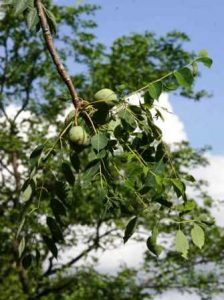
Sclerocarya birrea subsp. caffra. Photo: Bart Wursten. Source: Flora of Zimbabwe
The marula, which has now reverted to its old name Sclerocarya birrea subsp. caffra, illustrates another ANACARDIACEAE feature, they often have separate male and female trees. George Hall told us how he had persuaded the people of Chibi district not to destroy non fruiting marulas for what could the females do without males? This medium to low altitude tree often grows on rocky kopjes and alluvium.
All the simple leaved Ozoroa species have a characteristic venation with straight lateral veins at a right angle to the mid-vein. We are all familiar with O. insignis subsp. reticulata, with furry leaves which are often in whorls of 3. The ANACARDIACEAE resins have been strongly selected for muti by the Ngangas, and Tom’s trees have taken a hammering, particularly O. longipetiolata where the trees are almost entirely ring barked and bear dire warnings in the vernacular. This dyke endemic has bluish glabrous leaves. It was really exciting to see O. obovata var elliptica, a small leaved species from the cretaceous sands of the S.E. lowveld. It has a very bicoloured leaf with a green dorsal surface and grey underside. We did not see the 4th Ozoroa, O. paniculosa which is grey leaved and grows near the Chewore mouth in the south on a local outcrop of dyke like basic rocks.
The third group, the trifoliolate Rhus species is by far the largest. In all there are about 16 indigenous tree species of which we examined 10, starting with R. gueinzii var. spinescens which has shiny leaves and characteristic lateral spurs formed by side branches. This species can be found on rocky ridges in South east of Zimbabwe.
R. natalensis is another localized species forming a bush of shiny evergreen leaves, occurring in the higher rainfall woodland of Mutare and the Victoria Falls. The leaves have a scalloped edge and red petioles. We are fairly familiar with the broad crenate leaves of the widespread R. tenuinervis common on termite mounds. Tom was disappointed that he was unable to show us R. culminum from Mount Inyangani as his specimen had just died. Another commonly seen species is R. leptodictya with finely serrated lanceolate leaves. This plant grows on granite kopjes and is often green even during the dry season.
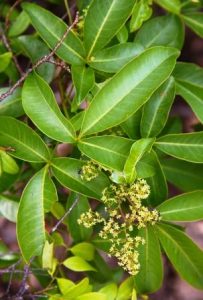
Rhus chirindensis. Photo: Bart Wursten. Source: Flora of Zimbabwe
Alongside the Dyke Ozoroa Tom showed us the attractive serpentine R. tenuipes with long delicate leaflets exaggeratedly toothed and a red petiole. This species is restricted to the dyke in the midlands area. Climbing near the top of Tom’s new river we saw R. dentata, essentially a high rainfall species in open woodland. This small tree is not often seen and has fairly rough, wrinkled dark green leaves with a dentate margin. Nearby we were shown R. tomentosa with soft bicoloured leaves which were very white underneath. This plant is restricted to the Eastern highlands up to an altitude of 2500 m. Alongside it we saw R. chirindensis which has enormous leaflets with an entire margin and pink petiolules and is a forest edge species.
I was originally introduced to this genus in the Cape where the species are incredibly similar and confusing, but in view of the long summer drought, all have a waxy cuticle over the leaves which reduces transpiration. Rhus can therefore be distinguished from other trifoliate leafed shrubs (not that the Cape has many others) by bending the leaflet which cracks the cuticle resulting in a white band across the blade. Only one of these drought resistant species occurs in Zimbabwe, R. lucida which grows in the dry forests in the south. So it was somewhat nostalgic to repeat this little test in the Botanical Gardens.
In the fading light we saw the forms of R. lancea lining the pond near the car park. An interesting pamphlet from the South African forestry department has a copy of a drawing by William Burchell of two Karee trees, R. lancea, in Karroopoort near Ceres. These two trees were photographed in 1949, 138 years later. By 1954 one of these trees had been felled, and the remaining tree was chopped down in 1978 when a power line was erected through Karroopoort. Rather a fantastic life expectancy for this most unassuming species.
Well, thanks Tom, once again for a well worthwhile visit.
-Kim ST. J. Damstra
OUTING TO MAZOWE DAM WALL AND TRANDRA FARM, SUNDAY 18TH SEPTEMBER 1983
This month the Harare folk spent the morning exploring the riverine vegetation below Mazowe Dam wall. We initially walked from the bus, along a path which led to the base of the dam wall.
One of the first trees to catch the eye was Rhus longipes which is always one of the first to flush into new leaf in the spring. The fresh apple green leaves are very pleasing to the eye. Soon after we encountered Acokanthera oppositifolia, the bushman’s arrow poison, which is something we seldom see on our outings. The specimen we saw was more of a scrambling bush, but was still a pleasant sight as it was in flower. The flowers were in little pink bunches clustered along the branches. The individual flowers consist of narrow inch long tubes with the petals spreading out at the end.
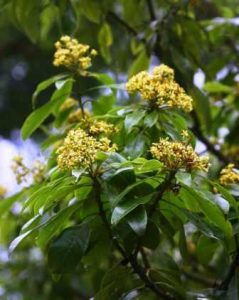
Pittosporum viridiflorum. Photo: Bart Wursten. Source: Flora of Zimbabwe
A little further along the path we came across the first of many Pittosporum viridiflorum, in fruit. We then found Ekebergia capensis, some of which bore red autumn leaves together with the brand new spring flush of green leaves. This tree is very similar to the exotic Toona ciliata which we think we also saw.
Those of us who ventured to distinguish between them did so on the basis, I think, of “gut feelings”.
Getting nearer the river we started seeing many fine river combretums, Combretum erythrophyllum, which were immediately recognizable from the “cat’s claw” or “leopard’s claw” markings on the bark. Also my observation on these threes is that one very rarely finds one which is really vertical. While on combretums, we did also see the large fruited C. zeyheri on the steeper ground nearer the dam wall, and also C. collinum in flower. Just to confirm, we found its fruit on the ground below, being one step down size from those of C. zeyheri. Meg Coates Palgrave pointed out a tip for C. collinum that is that the under surface of the leaf tends to be velvety while the upper surface is smooth. I believe that one member also found C. mossambicense, a scrambling bush, which is more common as a constituent of the lowveld jesse.
High up the slope in the gorge were solitary specimens of Kirkia acuminata and Albizia versicolor, the poison pod (poisonous to cattle if the pods are green). Also in this area we saw a small tree which turned out to be Zanha golungensis, the much rarer sibling of Z. africana. The basal leaflets on Z. golungensis tend to be smaller than those on Z. africana, and the mature leaves are hairless, unlike Z. africana which are hairy. It still has the characteristic “ball and claw” growing tip. Incidentally, this had not previously been recorded from this spot and did not appear on the distribution map.
A feature of the day were the many large specimens seen along the river of Celtis africana, Bequaertodendron magalismontanum, Ilex mitis and Rauvolfia caffra in flower, also a few magnificent Mimusops zeyheri with characteristically fissured bark, vaguely reminiscent of crocodile skin.
Also fairly common in the riverine growth here was Apodytes dimidiata with which we had become quite familiar at the Palm Block. This tree can quite easily be confused with Ilex, but the leaves of Apodytes tended to be more droopy.
Another exciting discovery was Chionanthus battiscombei with distinctive white twigs and opposite dark green leaves with acarodomatia i.e. pits in the axils of the veins.
At the crest of the river bank at one point we saw a sizeable Strychnos potatorum which compared favourably in size with the one seen last month at Ivordale Farm, although not in fruit. It did, however, have leaves which demonstrated the typical Strychnos feature of having three main veins from the base of the leaf.
En route downstream to the bridge where the bus was waiting for us we admired a fair sized Schrebera alata carrying ripe pear shaped pods which split open into two halves so that one was reminded of a hippo yawning. The specific name refers to the winged petiole and rachis which was more obvious on some juvenile specimens we had seen earlier than on this mature tree.
Our party which had walked down the opposite bank of the river returned with a specimen of Myrica serrata which I believe was off quite a large tree. This specimen was then passed around the bus.
The bus then took us to Alan and Helen Foot’s farm “Triandra” near the line of rail running south from Jumbo Mine. Some of us had the honour to lunch under the spreading boughs of an enormous Ficus sycomorus in the garden. Behind the house near the barns, two Stereospermum kunthianum were in flower.
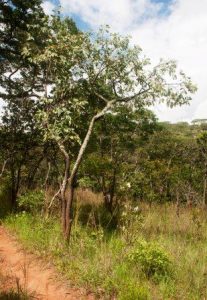
Ochna gambleoides. Photo: Bart Wursten. Source: Flora of Zimbabwe
In the afternoon the energetic members braved the heat to climb a kopje. The object was to see if we could relocate the very rare Ochna gambleoides which had been discovered there on the 1978 outing. Well, we did find it after a while, in fact two trees and a baby. The leaves were larger and rounder than the other Ochna species we see. It also showed the distinctly blue grey colour of the leaves, rather like those of the small leafed O. glauca which occurs in the Matopos. The ready to bust flower buds were also considerably larger than those on O. schweinfurthiana which were conveniently close at hand to compare with. The bark, though similar, did not flake in quite such distinct squares as O. schweinfurthiana.
Coming down from the top of the hill we saw a single specimen of Acacia nilotica, given away by its singular pods, and being rather out of place in this habitat and relatively high altitude. Nearby, were some large Steganotaenia araliacea and some Diospyros kirkii.
Amongst the numerous other trees we saw in the area and worthy I think of special note, were the many Lannea discolor, all quite leafless but flowering profusely with spikes of yellow flowers at the ends of the branches.
We all thank Alan and Helen warmly for once again welcoming us to share their trees with us and rounding off an enjoyable day.
STOP PRESS : Since writing the above I have been told that a Syzygium specimen which was collected below the dam wall, and which I had casually overlooked, was in fact identified as S. masukuense subsp. masukuense, which taken for identification by Bob Drummond at the Herbarium, after much head scratching. This is very unusual for this region, belonging more commonly to the Eastern Districts.
-Phil Haxen
MATABELELAND NOTES
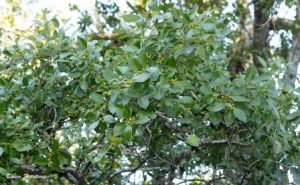
Maytenus undata. Photo: Bart Wursten. Source: Flora of Zimbabwe
Our September meeting was again at Hillside Dams. We met at the Upper Dam, alarmingly low, alas! and walked along the path to the north of the dam. Among us were three visitors, hopefully future members, so we tended to concentrate on familiar trees, thus refreshing our memories and finding out yet more about them. The trees were mostly bare, not a good season for beginners, and we had some difficulty in identifying some of them. Three varieties of Ficus were in full leaf, F. glumosa, F. sur and F. natalensis – which saved the landscape from appearing entirely desolate. The last named is open to doubt as nobody in the party was familiar with the names of the small leaved varieties. They were all clinging to rocks with fantastically shaped roots. There was a beautiful specimen of Maytenus undata in full leaf, these leafy trees were particularly welcome among all that bareness. We were just in time for the last of the colour on Pseudolachnostylis maprouneifolia, most of the leaves having fallen, and there was a very red Faurea saligna. The Dombeya rotundifolia were in flower and we found one of the delicate pink variety.
The party voted against going to the Matopos next month, very hot, very bare and too many mopane bees! We have been invited by Mrs. Phyllis Cabot to visit her home at Lakeside, so meet at the Hotel Rio at 0830 hours.
-Dora Webb
MATABELELAND CALENDAR
Sunday November 6th : I propose to go to Somerset Estate, a short distance beyond the Hotel Rio where there are more Securidaca longipedunculata than I have ever seen anywhere else. Janet and I went there two years ago and the profusion of blossom scented the air. It will be hot, so an early start will be advisable.
Sunday November 18th : An extra. The Ornithological Society invites you to an evening of slides given by Roger Clarke. Roger showed us slides which he took in the Antarctic where he has recently spent five months, and they were so good, and his commentary so interesting that we have asked him to give us another show. This will be on the Galapagos and Easter Island, both of which remote places he has visited. This will definitely not be about trees, and very little about birds, but I can assure you of a fascinating evening. It will be at the Museum at 2000 hours.
Sunday December 4th : Annual General Meeting. Details later. And this rounds off the year.
ROOT NOTE : Trevor Gordon asked us to thank everyone for the get well card we signed on the August outing, the op was successful and Trevor is recovering well.
J.P.Haxen
ROOT NOTE : This is to give notice that the 1984 subscriptions will be increased by a dollar, i.e. single membership $5; and Family/Institutional membership $6. This is less than one might expect, but is necessary to keep up with inflation.
J.P.Haxen
ROOT NOTE : The interesting note in the August Newsletter concerning our July inspection with Tom of the SAPINDACEAE in the Botanic Garden, reminds me of the fact that the genus Blighia is named after Captain Bligh of the Bounty. It is not however the plant which is reputed to have played so fateful a part in the Mutiny on the Bounty. That was the breadfruit plant, an Artocarpus sp., MORACEAE, a consignment of which Captain Bligh was taking from Tahiti to Jamaica, where food for slaves was short. During the voyage, drinking water became scarcer and scarcer and the plants were given a better ration than the sailors. Incidentally, the whole expedition was organized by Sir Joseph Banks, in whose honour the Banksia was named.
Dick Petheram
ROOT NOTE : Another interesting comment on the SAPINDACEAE came from Wendy Bullock, once a pillar of the Matabeleland Branch but now living in Chimanimani. It was exciting to learn that Erythrophysa transvaalensis was first recognized in the country from a specimen discovered by Alec Dry on a Tree Society outing to the lone baobab near Khami Ruins. Bob Drummond went to see this exciting tree full of the ‘red balloon’ fruit. It transpires that an earlier collection from Double Cross Ranch, Gwanda, had not been recognized. Seed from this specimen is now growing in the Bullock’s old garden at 8 Chapman Road, Burnside. As these are the only known plants my comment on their being ‘locally common’ should be deleted. Wendy added a further correction and note : “Pappea capensis was Lobengula’s (not Rhodes’) Indaba Tree. As far as I know the specimen at Government House, (his 2nd Bulawayo) is still living. When we first went to Bulawayo 25 years ago there was a specimen at his original Bulawayo already being strangled by Ficus burkei and this has since completely disappeared but the spot is marked by a commemorative stone on the roadside near the old Jesuit Mission”. Thank you for that information, it is much appreciated.
Kim ST.J.Damstra
ROOT NOTE : In the first part of his article on the trees near Midmar Dam, Pietermaritzburg, (Tree Life 43), Mr. C. Wigg of Matabeleland mentions finding Clausena anisata without any smell at all. On a recent trip to Juliasdale the Haxens and I found numerous Clausena specimens, one with an unmistakable aniseed smell although many in the gulley forest of Mt. Inyangani had an unpleasant smell more appropriate to the Afrikaans name ‘perdepis’ (horse urine). Mr. Wigg continues “Although the very tall trees were difficult some progress could be made from the bark. The peculiar patterns of concentric circles on the under bark told the presence of the lone local member of the TRIMENIACEAE family, Xymalos monospora or lemonwood. This tree can also be recognized by the conspicuous midrib and veining which gives the leaves a characteristic quilted appearance.
Then we have the magnificent protected PODOCARPACEAE, the Outeniqua yellowwood has a short narrow leaf, not exceeding 5 cm. and its bark peels in irregular pieces. P. henkelii, Henkel’s yellowwood has leaves up to 17 cms long and the bark in mature trees peels in long narrow strips. P. latifolius has slightly shorter and wider leaves than P. henkelii and its bark peels in narrow vertical flakes. The leaves of P. henkelii however droop whereas the others grow erect so that it is easier to tell them apart in the open rather than in the forest.
An unexpected addition to the combretum group Combretum kraussii, the forest bushwillow, whose leaves are dark green and glossy above and silver white below.
Finally we were told by visitors that a particular garden tree there was a Rhus. This was hotly denied as the specimen had an imparipinnate compound leaf with 7 or 8 pairs of opposite leaflets. The writer convinced himself it was Harpephyllum caffrum, wild plum, but noted that H. caffrum belonged to the same family as the Rhus viz. ANACARDIACEAE. Subsequently on a hurried visit to the Botanical Gardens in Maritzburg a tree with the same characteristics as the garden specimen was found under a Rhus label but, the species was strange and said to be a native of China and Japan. Were the visitors right after all?
-C. C. Wigg
ROOT NOTE : Mrs. Pat Lorber of Bulawayo has had considerable success in transplanting indigenous trees. The trees are about ten feet tall and leafless when she moves them. She digs a hole of about a meter in diameter around the tree, cuts the roots and lifts the tree into the prepared hole, planning the roots at approximately the same depth as they were originally. In this was she has successful moved 4 Pterocarpus angolensis, Cussonia natalensis, Erythrina lysistemon, Rhus lancea and Lannea discolor she was unsuccessful with Diplorhynchus condylocarpon, Faurea saligna and Albizia amara. The trees were taken from open land adjoining her property and did not have much chance of survival there.
-Dora Webb
ROOT NOTE : At the moment Harare is smothered by the sweet scent of Melia azedarach, one of the syringas discussed in Tree Life No. 42. Our treasurer, Brian Best, has unearthed some interesting facts concerning its uses which includes the practical aspects of how the wood can be used as a fuel, the leaves are suitable as green manure or powdered as an insect repellant and can even be eaten if cooked. The seeds provide an oil for soap and hair oil and there is also the useful information that the wood makes excellent cradle boards, ladles and deer calls for the Kickapoo Indians of Mexico. The exciting information is that although the seeds are most poisonous, I know people who claim to have eaten them as children. This report states that “If eaten with substances containing tannin, the poison is often without effect. In the past this has led to contradictory reports about the toxicity”.
Kim ST.J. Damstra
ROOT NOTE : We are all aware that plants lose water through tiny holes called stomata, in their leaves. This process is called transpiration. I am always amazed at the volume of water that is lost to the atmosphere in this way. Town planners have successfully drained vleis simply by planting gum trees. We recently learned that the Sabi River, which has been limited to standing pools for the past twelve months, had begun flowing again although no rain has fallen. This well known phenomenon is ascribed to a cold spell a few days earlier which kills leaves on the hardier of the deciduous trees, stopping transpiration. The ground water that was lost through the stomata is now available as run off and the rivers begin flowing. Along the northern escarpment late season fires similarly reduce transpiration and as a result the rivers of Matusadona begin flowing before the summer rains. A remarkable phenomenon indeed.
Kim ST.J. Damstra


